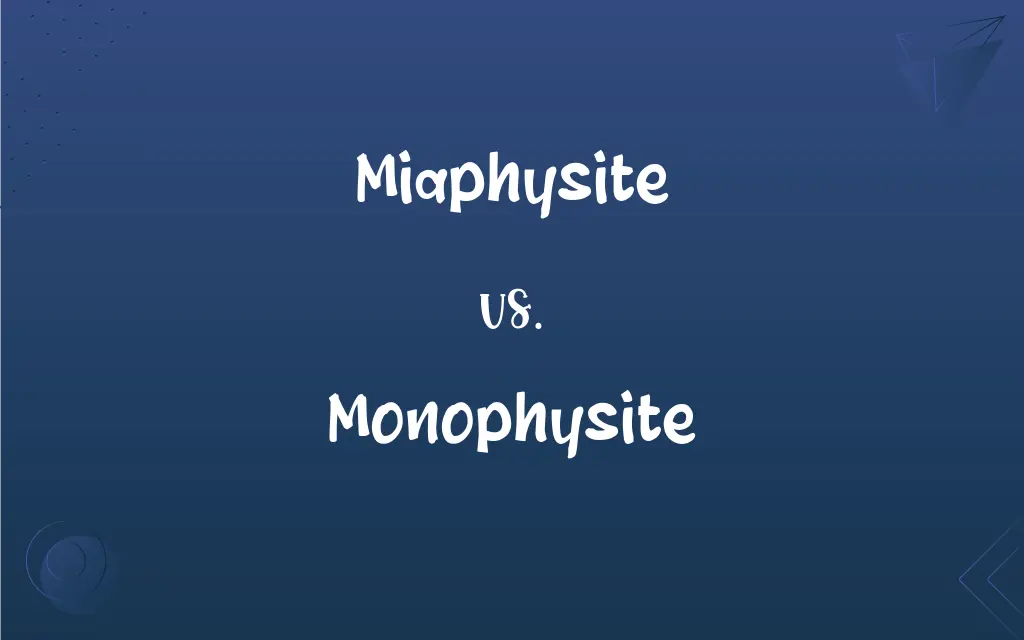Miaphysite vs. Monophysite: What's the Difference?
By Janet White & Harlon Moss || Updated on May 21, 2024
Miaphysite refers to the belief in the unified divine and human nature of Christ, while Monophysite suggests Christ has a single divine nature, overshadowing His humanity.

Key Differences
Miaphysite theology, primarily associated with the Oriental Orthodox Churches, asserts that Christ has one united nature that is both fully divine and fully human. Monophysite, often considered a pejorative term, claims that Christ has only one nature, which is predominantly divine.
Miaphysites argue that their position maintains the balance of Christ’s divinity and humanity, avoiding extremes by upholding both natures within one united nature. Monophysites, on the other hand, are often accused of leaning towards an overemphasis on Christ’s divinity at the expense of His humanity.
The Miaphysite belief emerged from the Council of Chalcedon (451 AD) and is upheld by churches like the Coptic Orthodox, Syriac Orthodox, and Armenian Apostolic Church. Monophysitism was deemed heretical by the same council, which affirmed that Christ is in two distinct natures, fully divine and fully human.
Miaphysites reject the Monophysite label, stressing that their doctrine does not deny Christ's humanity but integrates it fully with His divinity. Monophysitism, in historical context, was often misunderstood or misrepresented, leading to significant theological and political conflicts.
The distinction between Miaphysitism and Monophysitism has significant ecclesiastical implications, impacting relations between different branches of Christianity. Miaphysitism remains a cornerstone of the Oriental Orthodox Churches, while Monophysitism is largely rejected by mainstream Christianity, including Eastern Orthodoxy and Roman Catholicism.
ADVERTISEMENT
Comparison Chart
Core Belief
Unified nature of Christ, both divine and human
Single nature of Christ, primarily divine
Nature of Christ
One united nature
One predominantly divine nature
Emphasis
Balance of divinity and humanity
Overemphasis on divinity
Historical Context
Emerged from rejection of Council of Chalcedon
Deemed heretical by Council of Chalcedon
Church Association
Oriental Orthodox Churches
Viewed as heretical by mainstream Christianity
ADVERTISEMENT
Self-Identification
Rejects Monophysite label
Often considered pejorative or misrepresented
Miaphysite and Monophysite Definitions
Miaphysite
Originated in opposition to the Council of Chalcedon’s definition.
Miaphysitism developed as a distinct theological stance post-Chalcedon.
Monophysite
Considered heretical by the Council of Chalcedon.
Monophysite views were rejected as heretical in 451 AD.
Miaphysite
Emphasizes the coexistence of divinity and humanity in Christ.
Miaphysite doctrine upholds that Christ is fully God and fully man.
Monophysite
Overemphasizes Christ's divinity over His humanity.
Monophysite doctrine downplays the human aspect of Christ.
Miaphysite
Maintains a balanced view of Christ’s nature.
Miaphysite teaching seeks to avoid the extremes of Monophysitism and Dyophysitism.
Monophysite
Belief that Christ has a single, primarily divine nature.
Monophysitism suggests that Christ's humanity is absorbed by His divinity.
Miaphysite
Central to Oriental Orthodox Christianity.
The Armenian Apostolic Church follows Miaphysite beliefs.
Monophysite
Associated with early theological controversies.
Monophysitism was central to early Christian debates on Christ's nature.
Miaphysite
Belief in the single, united nature of Christ that is both divine and human.
The Coptic Orthodox Church adheres to Miaphysite theology.
Monophysite
An adherent of the doctrine that in the person of Jesus there was but a single, divine nature.
Miaphysite
(theology) Of or pertaining to Miaphysitism; maintaining that Christ has a single, though composite, nature.
Monophysite
Alternative case form of Monophysite
Miaphysite
A believer in Miaphysitism, (specifically) a member of the Oriental Orthodox Church.
Monophysite
Describing the beliefs of a Μonophysite.
Monophysite
One of a sect, in the ancient church, who maintained that the human and divine in Jesus Christ constituted but one composite nature. Also used adjectively.
Monophysite
An adherent of Monophysitism
Monophysite
Of or relating to Monophysitism
Monophysite
Often a misrepresented or pejorative term.
Many who are labeled Monophysite reject the term as inaccurate.
FAQs
How do Miaphysite and Monophysite views differ?
Miaphysites believe in the unity of Christ's divine and human natures, while Monophysites believe Christ's divine nature overshadows His human nature.
Why is Monophysitism considered heretical?
Monophysitism is considered heretical because it overemphasizes Christ's divinity at the expense of His humanity, contradicting the Council of Chalcedon's definition.
Is the term Monophysite used accurately today?
The term Monophysite is often seen as pejorative or misrepresentative of the actual beliefs of those labeled as such.
What is the core belief of Miaphysitism?
Miaphysitism holds that Christ has one united nature that is both fully divine and fully human.
Which churches adhere to Miaphysite theology?
The Coptic Orthodox, Syriac Orthodox, and Armenian Apostolic Churches adhere to Miaphysite theology.
Which term is associated with Oriental Orthodox Christianity?
Miaphysite is associated with Oriental Orthodox Christianity.
What does Monophysitism claim about Christ's nature?
Monophysitism claims that Christ has a single nature that is primarily divine.
What was the Council of Chalcedon's stance on Christ's nature?
The Council of Chalcedon affirmed that Christ is in two distinct natures, fully divine and fully human.
What does Miaphysitism avoid by uniting Christ's natures?
Miaphysitism avoids the extremes of denying either Christ's divinity or humanity.
How does Miaphysitism maintain a balance in Christ's nature?
Miaphysitism maintains that Christ's divinity and humanity coexist within a single, united nature, avoiding extremes.
Is Monophysitism still a major theological stance today?
Monophysitism is largely rejected by mainstream Christianity, though historical misinterpretations persist.
Do Miaphysites reject the Monophysite label?
Yes, Miaphysites reject the Monophysite label, emphasizing their belief in the full integration of Christ's divine and human natures.
How is Christ perceived in Miaphysite theology?
In Miaphysite theology, Christ is perceived as fully God and fully man in one united nature.
What motivated the development of Miaphysitism?
Miaphysitism developed as a distinct stance to uphold the unity of Christ's divine and human natures post-Chalcedon.
Which belief system is more accepted in mainstream Christianity?
Miaphysitism is more accepted in Oriental Orthodox Christianity, while mainstream Christianity, including Eastern Orthodoxy and Roman Catholicism, follows Chalcedonian definitions.
What theological stance does the Armenian Apostolic Church follow?
The Armenian Apostolic Church follows Miaphysite theology.
Which belief system emerged from rejecting the Council of Chalcedon?
Miaphysitism emerged from rejecting the Council of Chalcedon’s definition of Christ's nature.
How does Monophysitism view Christ's human nature?
Monophysitism views Christ's human nature as overshadowed or absorbed by His divine nature.
Do Miaphysites and Monophysites share any common ground?
Both stress the importance of Christ's divine nature but differ significantly in how they view His humanity.
Why do Miaphysites emphasize Christ’s full humanity?
Miaphysites emphasize Christ’s full humanity to maintain a balanced and integrated view of His nature.
About Author
Written by
Janet WhiteJanet White has been an esteemed writer and blogger for Difference Wiki. Holding a Master's degree in Science and Medical Journalism from the prestigious Boston University, she has consistently demonstrated her expertise and passion for her field. When she's not immersed in her work, Janet relishes her time exercising, delving into a good book, and cherishing moments with friends and family.
Co-written by
Harlon MossHarlon is a seasoned quality moderator and accomplished content writer for Difference Wiki. An alumnus of the prestigious University of California, he earned his degree in Computer Science. Leveraging his academic background, Harlon brings a meticulous and informed perspective to his work, ensuring content accuracy and excellence.































































